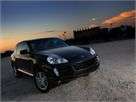Recent Articles
Popular Makes
Body Types
2008 Porsche Cayenne S Review
When is a Porsche not a Porsche?

Maybe our expectations were too high. The Cayenne S, after all, carries a Porsche crest on its nose. Yet after a week with this SUV, we came away disappointed. Sure, the Cayenne has good power, handles well for an off-road capable machine, and has some nice luxury features. Yet not once did we feel the connection we get when driving other Porsches, and subsequently, we felt as though the Cayenne isn’t really a Porsche. It’s not that we were expecting a 5,000 pound Cayman, but we think this Porsche should outperform a BMW X5, instead of the other way around.

The 2008 Cayenne S starts at an almost reasonable $58,795, that is, reasonable for a Porsche. It includes the 4.8-liter V-8 engine and six-speed automatic transmission, a low-range gearbox, Porsche Stability Management, and leather interior. Options included the $690 black paint job, $150 18-inch Cayenne Turbo wheels, $560 front seat and steering wheel heater, a $3,070 navigation system, $2,990 adjustable air suspension, $270 variable assist power steering, and a $1,190 moonroof. The options list also featured a $630 trailer hitch and $1,665 Bose surround sound system. Add it up and you have a $70,760 Porsche SUV.
Any 4.8-liter V-8 with a 385 horsepower output is something to contend with. However, this one has 4,906 pounds of SUV to lug around. The Cayenne is quick enough to get you around town, but it’s not what we’d call fast, especially for a Porsche. The six-speed automatic shifts quickly either on its own or in Tiptronic manual mode, although the steering-wheel mounted buttons are clumsy to use. Still, we want more, and though the Turbo offers 500 horsepower, it’s at a $30,000 premium. We’d love to see a model between the S and the Turbo, or maybe just more juice for the S.
Page 2
Set the suspension to “Sport” and you have handling that’s as precise and capable as a big brute can get. The 18-inch tires on our test car didn’t have as much grip as the available 20 inchers, but the lower limits may have worked in the Cayenne’s favor by lowering the limits and giving it a slightly tossable feel. It understeers at the limit, but the stability control didn’t intrude until the outer limits of adhesion. Yet you never escape the weight, and feel it in every quick side-to-side transition. The Cayenne may be the Fred Astaire of elephants, but it’s still an elephant.

The Cayenne is good, despite its weight, size and height. It’s comfortable on the road, but dial up the Sport mode and it’s satisfying on a mountain road. The V-8 provides good power, although more would be nice, and the brakes are tremendous. Yet every time we see that Porsche crest, we’re disappointed that it’s not more responsive and precise. Yeah, we have high expectations, but this is a Porsche, and that’s supposed to mean something even if it’s a big, heavy SUV. If it were a Volkswagen we’d love it, but as a Porsche, the Cayenne is disappointing.
Page 3
Cayenne drivers are rewarded with a big, comfortable chair for their task. It’s adjustable every which way, but we found that just the usual fore-aft and seatback angle adjustments were all that were needed. The leather is soft, the padding is comfortable without being too squishy, yet it’s also supportive for when you want to push the Cayenne. Overall it’s one of the better seats out there. The steering wheel falls readily to hand, but some of us felt it was too large.

Compared to the front seats – or the rears in many other competitive vehicles – the Cayenne’s rear seats leave a lot to be desired. The position is bolt-upright, and even though there’s good head room, the poor leg room is exacerbated by the hard plastic used on the back of the front seats. Don’t look for a seatback angle adjuster, because there isn’t one. The seat cushion is also low to the floor, so your knees are subsequently at an uncomfortable angle. Volkswagen and Audi do much better with the same platform, which makes the Porsche’s rear bench that much more inexplicable.
Filling up the cargo area is a breeze thanks to a big opening, a power liftgate that takes only three seconds to open, and a special “loading” level on the air suspension that settles the Cayenne onto its haunches like a kneeling camel. Beefy cargo hooks mount flush to the floor, and a handy hidden compartment to the left of the cargo area keeps small items hidden from view. The rear seats fold flat, but the Cayenne fights you as you remove the head restraints, flip the seat cushions forward and finally force the seatback down.
Our Cayenne was equipped with Porsche’s adjustable air suspension, which offers three different modes: Sport, Normal and Comfort. Sport is, obviously for sporty driving, while the Normal and Comfort settings are just as self-descriptive. We found ride quality to be good in all three modes, surprising considering how relatively agile the Cayenne is in Sport mode. Normal provided the best highway ride; Comfort was too soft, making the Cayenne feel floaty and unwieldy. The suspension also alters ride height over a wide range, from a bumpin’ load-only mode to a tippy-toes mode for off-road adventures.
Good, but not great. The view forward is very good, and the raised fender blisters help remind you that this is, in fact, a Porsche. Large side mirrors help in changing lanes, and the side glass is large, too. The second-row head restraints poke up and intrude on the rear view, and the rearmost pillars are quite thick, further impeding things. The rear glass itself is large, but it’s still confining. Surprisingly, at our test car’s $70,000-plus sticker, a backup camera and even backup sensors are still optional; they should be standard.